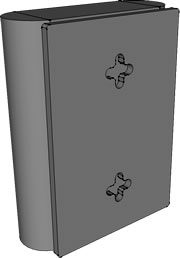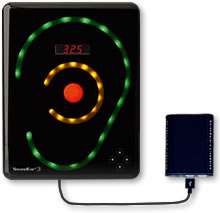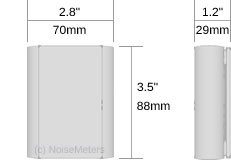
The delivery price is calculated during checkout based on your location and the goods ordered. Our basic delivery prices are:
Delivery within Netherlands, The: €27.00
Delivery Service: Three working days*
* For products that are in stock and the order received by midday.
Some products go through a final configuration and calibration before being shipped. If the calibration labs are busy this can add up to two days on to the delivery schedule but guarantees a fresh calibration.
The LN2 LiveNoise Terminal is for customers who already have a SoundEar 3 or SoundEar 3 Industrial noise warning sign, or the SoundEar 3-320 noise processor. The LN2 module is added to your existing SoundEar 3 units to provide data logging, network connection and reporting through our cloud server using your web browser.
A system can consist of one or more LN2 enabled noise monitors. They connect to your local area network using either WiFi or a wired Ethernet connection.
The LiveNoise Terminal takes the noise measurements from the SoundEar 3, stores them, and sends them to our cloud server. It communicates continuously with the server to provide real-time noise levels, long-term noise measurements and high-noise alarms. You can use a web browser to access your LiveNoise Account to view these live levels or to generate daily, weekly or monthly reports.
The Noise Warning Sign can be mounted on a wall using a single screw. The LiveNoise Terminal is mounted close by using two screws or it can just sit on a shelf or other suitable surface.
If a more secure mounting method is needed or you want to angle the SoundEar noise sign (not included) away from the wall then an adjustable VESA mount is available. An extra security bracket is also available for the LiveNoise Terminal. Please contact us for more information.
A standard USB cable (included) connects the LiveNoise Terminal to the Noise Warning Sign. The system requires 5V DC, which is provided by the power adapter that is included.

The LiveNoise Terminal can be mounted on a wall using two screws, or it can lay flat on a shelf or desk.

A typical installation with a LiveNoise Terminal connected to a SoundEar 3 Noise Warning Sign. The SoundEar 3 is not included.
For greater security a VESA mount option is also available to mount the SoundEar 3.
The LiveNoise Terminal communicates with our cloud server over your existing network. It sends the noise measurements every minute so you can produce up to date reports. If anybody on the account is viewing live data then it also sends the sound levels every second. It uses a data efficient method so the bandwidth use is minimal. You won't notice these units on your network.
As the measurements are on a cloud server there is no software to install on your computer. You can access the live sound levels and the long term reports from anywhere using a web browser.
If a reliable WiFi signal is available then all the noise monitor needs is the network name and password to connect up. If you prefer a wired approach then connection can be made via an Ethernet connection (RJ45).
To view the live sound levels from any connected noise monitors you use your web browser to log in to your LiveNoise account.
You will be presented with the sound level at each location, updating every second and displayed as numbers, charts or a mixture of the two.
The background is a simple image (JPG format), which you can upload to your account. It can be a picture of the location, floor plan, satellite image, whatever you choose. Alternatively, you can ignore the background and just have the sound level or chart as a large, full-screen display.
If you have alarm trigger levels set up then the chart or numbers will indicate a warning level in yellow and an alarm level in red. If the level stays above the alarm level for the preset period of time then the window will flash red to attract attention.
Each remote noise monitor calculates the usual noise parameters over periods of 5, 10, 15, 30 and 60 minutes. These measurements are sent to the cloud server as soon as they are available so you can create noise reports using a web browser.
Your noise reports can be daily, weekly, monthly or over any custom period you choose. The reports show the sound levels in a chart or in a table.
The reports include many parameters, measured with both "A" and "C" frequency weightings and, where applicable, Fast and Slow time response. This includes the Leq (average sound level), Lmin and Lmax, as well as the statistical parameters L5, L10, L50, L90, L95 and L99. The charts also indicate the number of alarms detected in each period.
To generate a report you select which noise monitors you want to include, the time period you want to see (daily, weekly, monthly or custom) and the measurement period to use (5, 10, 15, 30 or 60 minutes). Your choices are remembered so you don't have to select everything each time.
You can leave the report on-screen and it will update automatically whenever new measurements are available.
The reports you generate in your browser can be exported to PDF or CSV files. A PDF export is useful for printing, emailing or just for your records. The CSV export produces a table of results that can be imported to a spreadsheet or other similar program.
| USB Port | For USB memory stick configuration |
| Ethernet Port | RJ45 socket |
| Internal Memory | 16 GB for up to 3 years storage |
| Dimensions | 70 x 88 x 29 mm, 2.8" x 3.5" x 1.2" |
| Power | 5 VDC, max 12W (power adapter included) |
